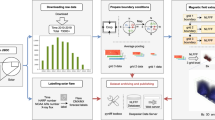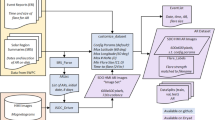Abstract
Solar magnetograms are important for studying solar activity and predicting space weather disturbances1. Farside magnetograms can be constructed from local helioseismology without any farside data2,3,4, but their quality is lower than that of typical frontside magnetograms. Here we generate farside solar magnetograms from STEREO/Extreme UltraViolet Imager (EUVI) 304-Å images using a deep learning model based on conditional generative adversarial networks (cGANs). We train the model using pairs of Solar Dynamics Observatory (SDO)/Atmospheric Imaging Assembly (AIA) 304-Å images and SDO/Helioseismic and Magnetic Imager (HMI) magnetograms taken from 2011 to 2017 except for September and October each year. We evaluate the model by comparing pairs of SDO/HMI magnetograms and cGAN-generated magnetograms in September and October. Our method successfully generates frontside solar magnetograms from SDO/AIA 304-Å images and these are similar to those of the SDO/HMI, with Hale-patterned active regions being well replicated. Thus we can monitor the temporal evolution of magnetic fields from the farside to the frontside of the Sun using SDO/HMI and farside magnetograms generated by our model when farside extreme-ultraviolet data are available. This study presents an application of image-to-image translation based on cGANs to scientific data.
This is a preview of subscription content, access via your institution
Access options
Access Nature and 54 other Nature Portfolio journals
Get Nature+, our best-value online-access subscription
$29.99 / 30 days
cancel any time
Subscribe to this journal
Receive 12 digital issues and online access to articles
$119.00 per year
only $9.92 per issue
Buy this article
- Purchase on Springer Link
- Instant access to full article PDF
Prices may be subject to local taxes which are calculated during checkout



Similar content being viewed by others
Data availability
The code is available at https://github.com/tykimos/SolarMagGAN. In the readme file, we explain the architecture and selected hyperparameters. The SDO data are available from the SDO data centre (https://sdo.gsfc.nasa.gov/data/), the Joint Science Operations Center (http://jsoc.stanford.edu/) and the Korean Data Center for SDO (http://sdo.kasi.re.kr/). The STEREO data are available from the STEREO Science Center (https://stereo-ssc.nascom.nasa.gov/data.shtml). We used the following open-source packages: NumPy (http://www.numpy.org) and Keras (https://keras.io/).
References
Solanki, S. K., Inhester, B. & Schussler, M. The solar magnetic field. Rep. Prog. Phys. 69, 563–668 (2006).
Lindsey, C. & Braun, D. C. Seismic images of the far side of the Sun. Science 287, 1799–1801 (2000).
Braun, D. C. & Lindsey, C. Seismic imaging of the far hemisphere of the Sun. Astrophys. J. Lett. 560, 189–192 (2001).
Lindsey, C. & Braun, D. C. Seismic imaging of the Sun’s far hemisphere and its applications in space weather forecasting. Space Weather 15, 761–781 (2017).
Goodfellow, I. et al. Generative adversarial nets. Adv. Neur. 2014, 2672–2680 (2014).
Isola, P., Zhu, J.-Y., Zhou, T. & Efros, A. A. Image-to-image translation with conditional adversarial networks. IEEE Proc. Comput. Vision Pattern Recog. 2017, 1125–1134 (2017).
Pesnell, W. D., Thompson, B. J. & Chamberlin, P. C. The Solar Dynamics Observatory (SDO). Sol. Phys. 275, 3–15 (2012).
Lemen, J. R. et al. The Atmospheric Imaging Assembly (AIA) on the Solar Dynamics Observatory (SDO). Sol. Phys. 275, 17–40 (2012).
Schou, J. et al. Design and ground calibration of the Helioseismic and Magnetic Imager (HMI) instrument on the Solar Dynamics Observatory (SDO). Sol. Phys. 275, 229–259 (2012).
Howard, R. A. et al. Sun Earth Connection Coronal and Heliospheric Investigation (SECCHI). Space Sci. Rev. 136, 67–115 (2008).
Kaiser, M. L. et al. The STEREO mission: an introduction. Space Sci. Rev. 136, 5–16 (2008).
Dere, K. P. et al. CHIANTIan atomic database for emission lines. Astron. Astrophys. Suppl. 125, 149–173 (1997).
Landi, E., Zanna, G. D., Young, P. R., Dere, K. P. & Mason, H. E. CHIANTI—an atomic database for emission lines. XII. Version 7 of the database. Astrophys. J. 744, 99–107 (2012).
Nitta, N. V. et al. Soft X-ray fluxes of major flares far behind the limb as estimated using STEREO EUV images. Sol. Phys. 288, 241–254 (2013).
Liu, Y. et al. Comparison of line-of-sight magnetograms taken by the Solar Dynamics Observatory/Helioseismic and Magnetic Imager and Solar and Heliospheric Observatory/Michelson Doppler Imager. Sol. Phys. 279, 295–316 (2012).
Acknowledgements
We thank the numerous team members who contributed to the success of the SDO mission, as well as the STEREO mission. We acknowledge the community efforts devoted to developing the open-source packages that were used in this work (NumPy and Keras). This work was supported by the BK21+ Program through the National Research Foundation (NRF) funded by the Ministry of Education of Korea, the Basic Science Research Program through the NRF funded by the Ministry of Education (NRF-2016R1A2B4013131), a grant from the NRF funded by the Korean government (number NRF-2013M1A3A3A02042232), the Korea Astronomy and Space Science Institute under the R&D programme supervised by the Ministry of Science and ICT, the Korea Astronomy and Space Science Institute under the R&D programme ‘Development of a Solar Coronagraph on International Space Station (Project No. 2019-1-850-02)’ supervised by the Ministry of Science and ICT, a grant from the Institute for Information & Communications Technology Promotion (IITP) funded by the Korea government (MSIP) (number 2018-0-01422, ‘Study on Analysis and Prediction Technique of Solar Flares’), and the Artificial Intelligence Laboratory at the InSpace Co., Ltd. The SDO data were (partly) provided by the Korea Data Center (KDC) for SDO in cooperation with NASA and the SDO/HMI Team, which is operated by the KASI.
Author information
Authors and Affiliations
Contributions
T.K., E.P. and H.L. contributed equally to this study. T.K., E.P., H.L. and Y.-J.M. devised the method, analysed data and wrote the manuscript. S.-H.B. participated in discussing the results and contributed to improving the methodology. D.L., S.J., I.-H.C., L.K., M.C. and K.-S.C. participated in discussing the results.
Corresponding author
Ethics declarations
Competing interests
The authors declare no competing interests.
Additional information
Publisher’s note: Springer Nature remains neutral with regard to jurisdictional claims in published maps and institutional affiliations.
Rights and permissions
About this article
Cite this article
Kim, T., Park, E., Lee, H. et al. Solar farside magnetograms from deep learning analysis of STEREO/EUVI data. Nat Astron 3, 397–400 (2019). https://doi.org/10.1038/s41550-019-0711-5
Received:
Accepted:
Published:
Issue Date:
DOI: https://doi.org/10.1038/s41550-019-0711-5
This article is cited by
-
Comparative analysis of machine learning models for solar flare prediction
Astrophysics and Space Science (2023)
-
Machine learning in solar physics
Living Reviews in Solar Physics (2023)
-
Development of solar east limb active regions occurrence detection system based on EUV intensity observations
Journal of Astrophysics and Astronomy (2023)
-
Generating Photospheric Vector Magnetograms of Solar Active Regions for SOHO/MDI Using SDO/HMI and BBSO Data with Deep Learning
Solar Physics (2023)
-
Effects of a series of large flares from a sunspot group eruption on VLF propagation
Astrophysics and Space Science (2023)



